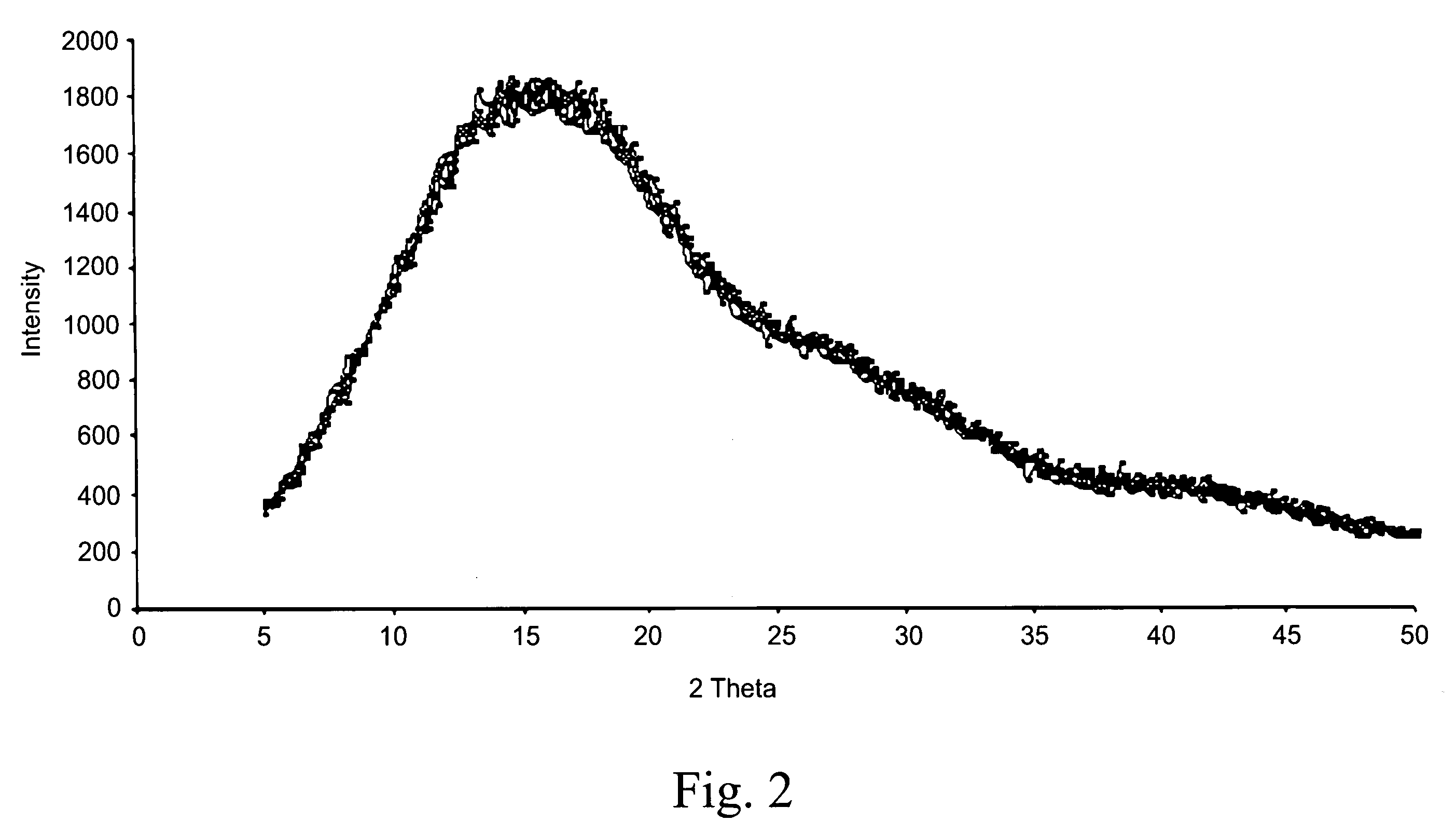pH sensitive polymer for inhibiting transformation in drugs
a polymer and transformation technology, applied in the direction of medical preparations, powder delivery, granular delivery, etc., can solve the problems of inability to absorb difficulty in swallowing solid oral dosage forms, and inability to tolerate oral administration, so as to maintain the bioavailability of the said drug
- Summary
- Abstract
- Description
- Claims
- Application Information
AI Technical Summary
Benefits of technology
Problems solved by technology
Method used
Image
Examples
example 1
[0122]The pH sensitive polymer is synthesized by solution polymerization. The hydrophobic monomer methyl methacrylate 60% by weight, hydrophilic monomer hydroxy ethyl methacrylate 25% by weight and basic monomer vinyl pyridine 15% by weight were used for the synthesis of the polymer. The monomers were dissolved in the solvent, dimethyl formamide. An azo initiator, azo bis isobutyronitrile was added to the monomer solution in dimethyl formamide. The reaction mixture was purged with the nitrogen gas to provide the inert atmosphere. The polymerization reaction was carried out by heating the reaction mixture to 65° C. for a period of 18 hours. The polymer so synthesized was recovered by precipitating in a nonsolvent. The nonsolvent diethyl ether was used. The polymer was dried at 27° C. under vacuum. The polymer was characterized for viscosity and molecular weight and for composition. The polymer composition, molecular weight and intrinsic viscosity of the polymer are summarized in Tabl...
example 2
[0124]pH sensitive polymers used for inhibition of crystallization of polymorphic drug at lower polymeric loading are polymers, which have higher molecular weight and high viscosity. The polymers of higher molecular weight were synthesized using the hydrophobic monomer, methyl methacrylate 60% by weight, hydrophilic monomer hydroxy ethyl methacrylate 25% by weight and basic monomer vinyl pyridine 15% by weight and varying the amount of initiator and the solvent. The polymers of the higher molecular weight were synthesized by reducing the initiator concentration with respect to the monomer content. Alternately the polymers of high molecular weight could be synthesized by reducing the amount of the inert solvent with respect to the monomer content.
[0125]The high molecular weight pH sensitive polymer of the present invention is synthesized by solution polymerization. The hydrophobic monomer methyl methacrylate, hydrophilic monomer hydroxy ethyl methacrylate and basic monomer vinyl pyri...
example 3
[0128]High molecular weight polymers are synthesized using the monomer composition methyl methacrylate 60% w / w, hydroxy ethyl methacrylate 25% w / w and vinyl pyridine 15% w / w in the presence of 51, weight % (of monomer) of dimethyl formamide as solvent and 0.0225% azo bis isobutyronitrile as initiator. The polymerization reaction was carried out by heating the reaction mixture to 60-70° C. for a period of 15-18 hours. The polymer so synthesized was recovered by precipitating in a nonsolvent diethyl ether. The polymer was dried at 27° C. under vacuum. The polymer composition is shown in Table 3.
[0129]The high molecular weight polymer is synthesized by using the monomer composition methyl methacrylate 60% w / w, hydroxy ethyl methacrylate 25% w / w, and vinyl pyridine 15% w / w in the presence of 34.72 weight % (of monomer) of dimethyl formamide as solvent and 0.045 weight %(of monomer) of azo bis isobutyronitrile as initiator. The polymerization reaction was carried out by heating the react...
PUM
| Property | Measurement | Unit |
|---|---|---|
| melting point | aaaaa | aaaaa |
| temperature | aaaaa | aaaaa |
| glass transition temperature | aaaaa | aaaaa |
Abstract
Description
Claims
Application Information
 Login to View More
Login to View More - R&D
- Intellectual Property
- Life Sciences
- Materials
- Tech Scout
- Unparalleled Data Quality
- Higher Quality Content
- 60% Fewer Hallucinations
Browse by: Latest US Patents, China's latest patents, Technical Efficacy Thesaurus, Application Domain, Technology Topic, Popular Technical Reports.
© 2025 PatSnap. All rights reserved.Legal|Privacy policy|Modern Slavery Act Transparency Statement|Sitemap|About US| Contact US: help@patsnap.com



